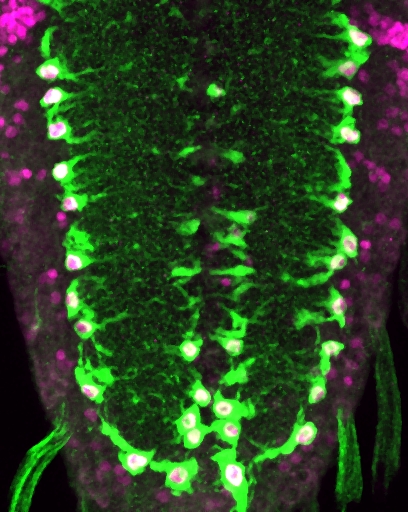
A gene network that controls repair to the central nervous system (CNS) after injury has been discovered in the fruit fly, Drosophila, by scientists at the University of Birmingham. This breakthrough may help to aid understanding of cell manipulation techniques necessary to repair damage to the human CNS, according to research published today (30 August) in the journal PLoS Biology.
A natural mechanism that promotes structural robustness in animals and encourages CNS repair has been investigated using fruit flies by looking at how cells respond to injury. Axons carry impulses between nerve cells and glial cells normally surround them. After injury, glial cells are responsible for re-enwrapping axons and supporting nerve cells, encouraging recovery. In both insects and mammals, glial cell numbers increase upon injury and this response can lead to modest recovery of nerve function.
Project Director Dr Alicia Hidalgo, Senior Lecturer from the School of Biosciences at the University of Birmingham, explains:
“Using fruit flies we have discovered a gene network that promotes repair to the central nervous system. We applied injury to the small nerve cord of Drosophila larvae of a range of genetic backgrounds.
“We found that the gene network enables glial cells to clear up cellular debris, to divide and differentiate, and restore normal glia-axon interactions, promoting repair. By removing the genes in the network, or adding them in excess, we can shift from prevention to promotion of lesion repair in the fruit fly.”
The researchers suggest that this gene network may reflect a common underlying genetic mechanism, which, if present in mammals, could help understand how to manipulate glial cells to help the human CNS self-repair.
Dr Hidalgo adds:
“Finding ways to promote central nervous system regeneration is one of the key aims of medical research in neuroscience. If this fruit fly gene network was conserved evolutionarily in human glial cells, it could help us to understand the cellular events and underlying molecular mechanisms that take place after spinal cord injury and demyelinating diseases and eventually contribute to finding therapeutic solutions for these conditions.”
This research was funded by Yamada Science Foundation and Royal Society Short Visit Fellowships, Marie Curie International Incoming Post-doctoral Fellowship and grants from the Wellcome Trust and BBSRC. For more information, please contact Dr Alicia Hidalgo via 0121 414 5416 or a.hidalgo@bham.ac.uk.
About the procedure
The gene network was uncovered by establishing an injury paradigm in fruit flies and using a combination of modern tools of Drosophila genetics, laser scanning confocal and time-lapse microscopy, transmission electron microscopy and image processing methods. Essentially, nerve cords of fruit fly larvae were dissected, stabbed with a fine needle and cultured for a period of time. This procedure was carried out in specimens in which genes were switched off, or turned on in excess, specifically in glial cells associated with axons. A set of interconnected genes was discovered, that affects the extent to which the nerve cords repair following injury. The gene network enables glia to divide upon injury, to prevent uncontrolled proliferation, and to differentiate. It also has homeostatic properties: two factors that increase cell division (Notch and NFB) maintain a factor that prevents cell division (Prospero), thus maintaining cell number under tight control. Prospero also enables glial cells to change shape, clear cellular debris and enwrap axons, restoring nerve cord integrity and priming glia for further responses. This gene network provides structural robustness and plasticity to the nervous system in the normal animal.
For media enquiries, please contact Amy Cory, University of Birmingham Press Office via 0121 414 6029 or a.cory@bham.ac.uk.